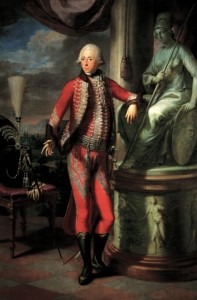
Prince Nikolaus Esterházy
Credit: Wikipedia
Pauer calls F sharp minor “…that dark, mysterious, and spectral key, [which] is at the same time full of passion.”
One of the most famous symphonies in F sharp minor is Haydn’s Farewell Symphony. His Symphony No. 45, written in 1772, comes with a story told by Haydn himself: Prince Nikolaus Esterházy and his court were at the summer palace at Esterháza for a longer than usual stay. The musicians had left their families back home in Eisendtadt and wanted to get home and asked Haydn to help them relay this message to the Prince. Haydn put their appeal in terms of music: in the final movement, as each player finished, he put out the candle on his music stand and left. By the end, there were only 2 violins left: Haydn himself and his concert master. The message was understood and the court departed for home the next day.
Consider the scene: the musicians in a darkened room, their music lit only by candle-light, and as they depart, one by one, the room gets darker and more mysterious. It must have been a truly impressive performance (even if the musicians might have been laughing off-stage).
Haydn: Symphony No. 45 in F-Sharp Minor, Hob.I:45, “Farewell”: V. Finale: Adagio (Orpheus Chamber Orchestra)
Concertos written in this key have a particular characteristic: they were generally written for the composer himself to play, which had the double effect of keeping other performers away from the work and permitting the composer to write to his own strengths.
Beethoven’s Piano Sonata No. 29, the Hammerklavier, has its slow movement in F-sharp minor and we can understand immediately why Pauer considered this a dark, mysterious and spectral key.
Beethoven: Piano Sonata No. 29 in B-Flat Major, Op. 106, “Hammerklavier”: III. Adagio sostenuto, appassionato e con molto sentiment (Charles Rosen, piano)
What pieces do you think should be added here? Keep in mind that the piece should date from before 1876, when Pauer’s book was published. Another guideline might be to note the relatively small list of composers he gave as examples: Haydn, Mozart, Beethoven, Mendelssohn, Schubert Rossini, Weber, and Spohr – all stalwarts of German classicism / romanticism.







It’s quite a forgotten key, but it got later some recognition. Faure’s Pavane (1887) and Scriabin’s Piano Concerto (1897) are some examples
There are 3 violin concerti at least: Vieuxtemps’ no 2, Lipiński’s no.1,op.14 and Wieniawski’s no.1 op.14.